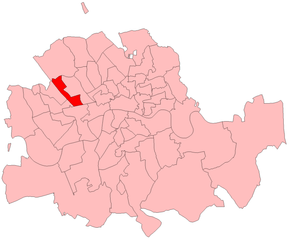Marylebone West (UK Parliament constituency)
| Marylebone West | |
|---|---|
|
Former Borough constituency for the House of Commons | |
| 1885–1918 | |
| Number of members | one |
| Replaced by | St Marylebone |
| Created from | Marylebone |
Marylebone West was a borough constituency located in the Metropolitan Borough of St Marylebone, in London. It returned one Member of Parliament to the House of Commons of the Parliament of the United Kingdom, elected by the first past the post voting system.

The constituency was created under the Redistribution of Seats Act 1885, and was formerly part of the two-seat Marylebone constituency. It was abolished for the 1918 general election.
Boundaries
The previous Parliamentary borough of Marylebone was split up in the boundary review of 1884-85. The new Parliamentary borough consisted of the parish of St Marylebone, and therefore had identical boundaries to the St Marylebone Vestry which was the main institution of local government. The Commissioners divided the parish into two Divisions, each of which contained four of the parishes' eight wards. Marylebone West division was defined as containing the Bryanstone, Hamilton Terrace, New Church Street, and Portman wards. The population in 1881 was 83,871.[1]
Members of Parliament
| Election | Member | Party | |
|---|---|---|---|
| 1885 | Frederick Seager Hunt | Conservative | |
| 1895 | Sir Horace Brand Townsend Farquhar | Liberal Unionist | |
| 1898 by-election | Sir Samuel Edward Scott, Bt | Conservative | |
| 1918 | constituency abolished | ||
Elections results
| Election | Political result | Candidate | Party | Votes | % | ±% | ||
|---|---|---|---|---|---|---|---|---|
| 1885 General Election Electorate: 7,566 Turnout: 5,490 (72.6%) | Conservative win Majority: 1,498 (27.2%) | Frederick Seager Hunt | Conservative | 3,093 | 56.3 | |||
| Henry Seymour Trower | Independent Liberal | 1,595 | 29.1 | |||||
| Sir Henry Edmund Knight | Liberal | 701 | 12.8 | |||||
| Rev. Joseph Robert Diggle | Independent | 101 | 1.8 | |||||
| 1886 General Election Electorate: 7,566 Turnout: 5,006 (66.2%) -6.4 | Conservative hold Majority: 1,122 (22.4%) | Frederick Seager Hunt | Conservative | 3,064 | 61.2 | +4.9 | ||
| Henry Seymour Trower | Liberal | 1,942 | 38.8 | +9.7 | ||||
| 1892 General Election Electorate: 8,052 Turnout: 5,389 (66.9%) +0.7 | Conservative hold Majority: 437 (8.2%) | Frederick Seager Hunt | Conservative | 2,913 | 54.1 | –7.1 | ||
| John Charles Foulger | Liberal | 2,476 | 45.9 | +7.1 | ||||
| 1895 General Election Electorate: 8,593 Turnout: 6,007 (69.9%) +3.0 | Liberal Unionist win Majority: 1,461 (24.4%) | Sir Horace Brand Townsend-Farquhar, Bt. | Liberal Unionist | 3,734 | 62.2 | (+8.1) | ||
| Bertram Stuart Straus | Liberal | 2,273 | 37.8 | –8.1 | ||||
| 3 February 1898 by-election[2] | Conservative win | Sir Samuel Edward Scott, Bt. | Conservative | unopposed | ||||
| 1900 General Election Electorate: 8,792 Turnout: 5,019 (57.1%) –12.8 | Conservative hold Majority: 1,955 (39.0%) | Sir Samuel Edward Scott, Bt. | Conservative | 3,487 | 69.5 | (+7.3) | ||
| William Hastings Sands | Liberal | 1,532 | 30.5 | –7.3 | ||||
| 1906 General Election Electorate: 8,365 Turnout: 6,237 (74.6%) +17.5 | Conservative hold Majority: 655 (10.6%) | Sir Samuel Edward Scott, Bt. | Conservative | 3,446 | 55.3 | –14.2 | ||
| Sir Henry Hamilton Johnston | Liberal | 2,791 | 44.7 | +14.2 | ||||
| January 1910 General Election Electorate: 8,576 Turnout: 6,925 (80.7%) +6.1 | Conservative hold Majority: 1,977 (28.6%) | Sir Samuel Edward Scott, Bt. | Conservative | 4,451 | 64.3 | +9.0 | ||
| Capt. Hon. Donald Alexander Forbes | Liberal | 2,474 | 35.7 | –9.0 | ||||
| December 1910 General Election Electorate: 8,576 Turnout: 5,855 (68.3%) –12.4 | Conservative hold Majority: 2,003 (34.2%) | Sir Samuel Edward Scott, Bt. | Conservative | 3,929 | 67.1 | +2.8 | ||
| Arthur Hewett Spokes | Liberal | 1,926 | 32.9 | –2.8 | ||||
References
- Leigh Rayment's Historical List of MPs – Constituencies beginning with "M" (part 1)
- Craig, F. W. S. (1989) [1974]. British parliamentary election results 1885–1918 (2nd ed.). Chichester: Parliamentary Research Services. p. 35. ISBN 0-900178-27-2.